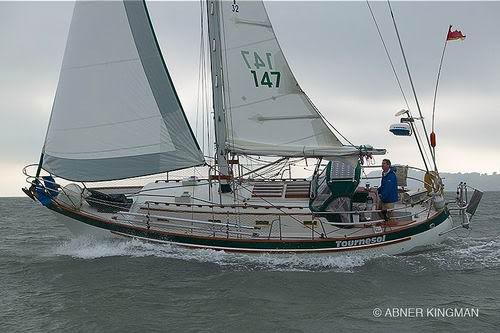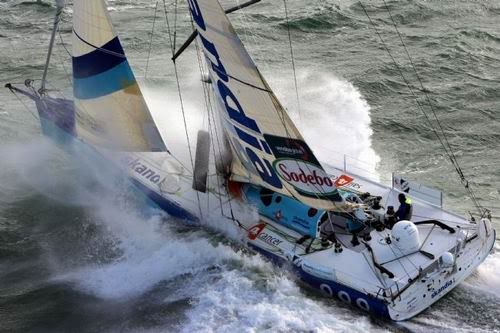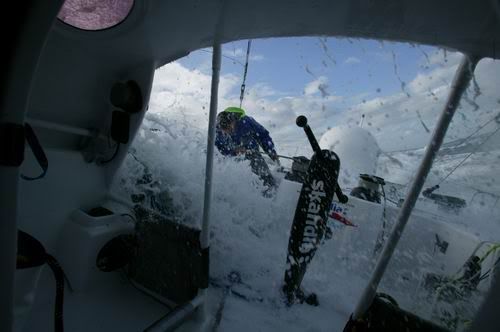
Blind sailor Scott Duncan conducts sea trials before setting out on his round the world sail.
Scott Duncan, 38, and Pamela Habek, 42, have left San Francisco for an around the world sail which would make them the first blind people to circumnavigate the Earth.
From The San Francisco Chronicle: byMichael Taylor
To the cheers of about a dozen well-wishers, some of them waving their white canes in the air, Duncan reversed his boat, Tournesol, out of its slip at Pier 39 at 12:35 p.m. Monday and the couple set out to circumnavigate the globe.
Carl Augusto, president and CEO of the American Foundation for the Blind, said that as far as he knows, this around-the-world voyage by a blind couple is a first. The foundation is one of about 25 sponsors that are helping to pay the estimated $300,000 cost of the two-year voyage.
For Duncan and Habek, it's a chance to show the world, as Duncan put it, that "disabled people can do this. We can't drive a car at 60 mph, but we can drive a boat at six knots." Before they set out Monday, they both worked as associate executive directors at San Francisco's Rose Resnick Lighthouse for the Blind and Visually Impaired and lived in San Francisco.
Duncan is not totally blind, but he has 20/450 vision in his left eye and what he calls "20-nothing" in his right. With corrective lenses, Habek's vision is 20/200. Jerry Kuns, a totally blind man who is a friend of Duncan and Habek, and who came along to help send them off, said, "They're seeing less than 10 percent of a normal person."
A couple of obvious questions come to mind for Duncan and Habek. How do you see where you're going? How do you know where you're going? How do you, well, sail this thing around the world without accidentally killing yourselves?
Duncan leads a couple of visitors down below and points out the array of electronic aids that help the modern sailor get nearly any place he wants to go.
"First and foremost, radar," Duncan said. "I can read it with a magnifying glass and it gives a broad picture of what's in front of the boat."
Then there's the talking Global Positioning System. It tells Duncan and Habek their speed, position and distance from various waypoints. They also have charts and a 10-power video magnifier -- a souped-up magnifying glass - - that they can place over charts.
These aids, along with his quarter century of experience in sailing, will help him and Habek get Tournesol down the coast to Panama, then out across the Pacific and Indian oceans, around the tip of South Africa, across to Brazil, then through the Panama Canal, to Hawaii and back home.
Asked why he's doing this, Duncan, who once taught at a camp for blind children, said, "I wanted to make a statement for visually impaired kids. I told the kids at the camp that you have to work harder when you're blind. I kept telling them they can do more than they think they can do.
"Next time you see a blind person, think, well, they're different, but I don't necessarily need to do something for them," he said. "Nothing drives me more crazy than when I'm crossing a street and someone grabs my arm."
It's a sentiment echoed by many blind people and certainly by the American Foundation for the Blind.
"Blind people are constantly struggling to be viewed as equal in their ability with sighted people," Augusto said in an interview from his home in New Jersey. "And sometimes it takes an extraordinary accomplishment on someone's part ... to show the sighted world that blind people are capable of living, working and achieving with dignity and success alongside their sighted peers."
Of course, Duncan has been pretty self-sufficient and successful for much of his life. He had his own company -- AccessAbility Inc., , a firm that made computer systems for the blind. He sold it and made enough money to be able, with help from the sponsors, to sail Tournesol around the world.
Asked about the possibility of hitting a barely submerged container that has fallen off that 900-foot freighter that might loom in their path some night, Duncan, whose T-shirt bears the legend "Fear Sucks," simply points out the boat's "ditch bag."
The ditch bag has food and water for five days, a first-aid kit and a radio transmitter that sends a signal to rescue authorities worldwide. The boat also has a life raft that can automatically inflate and a dinghy powered by an outboard motor.
For her part, Habek, who came to sailing later in life, says she's going on the trip because she had been working at the organization for the blind for 16 years and "it was the perfect time to transition into something else."
Habek is no stranger to the sea -- she grew up in Southwest Harbor, Maine, and her father was a longtime rigger for Hinckley Yachts, one of the world's best-known boatyards. But she didn't really get into serious sailing until she met Duncan.
"I have qualms," she conceded. "I think about things like thunder and lightning, and about the idea that there's no one on the bridge of a tanker."
Then suddenly, the voyage was at hand. The lines were singled up. The engine was churning. Duncan and Habek stood on the bow and their friends raised a toast of champagne.
"It's not often in life that you do something and at the same time send an important message and still have a wonderful adventure," Duncan said. "Cheers! We love you! OK, you guys, we're going to blow this place."
Readers may follow the voyage at www.blindsailing.com.




